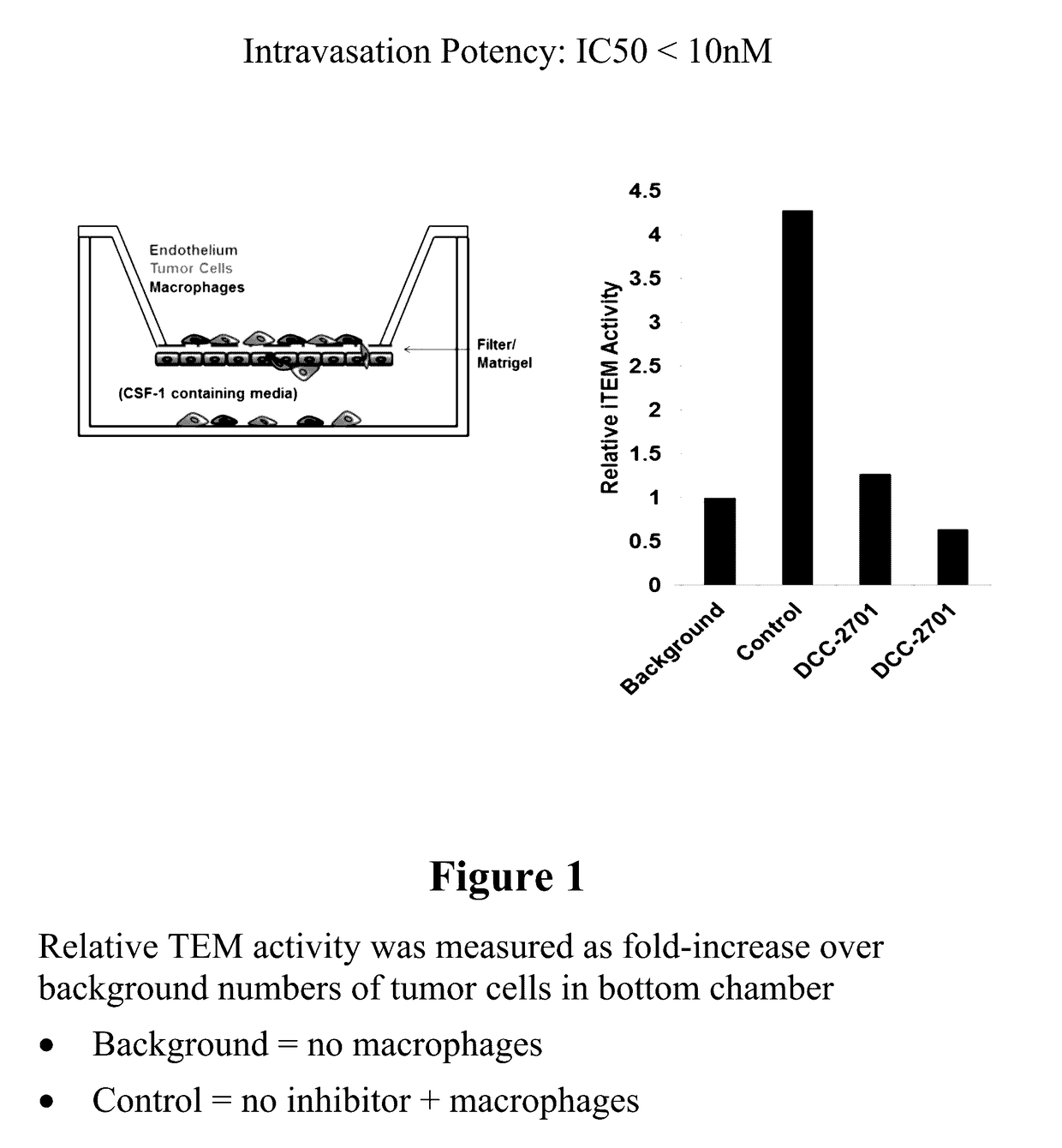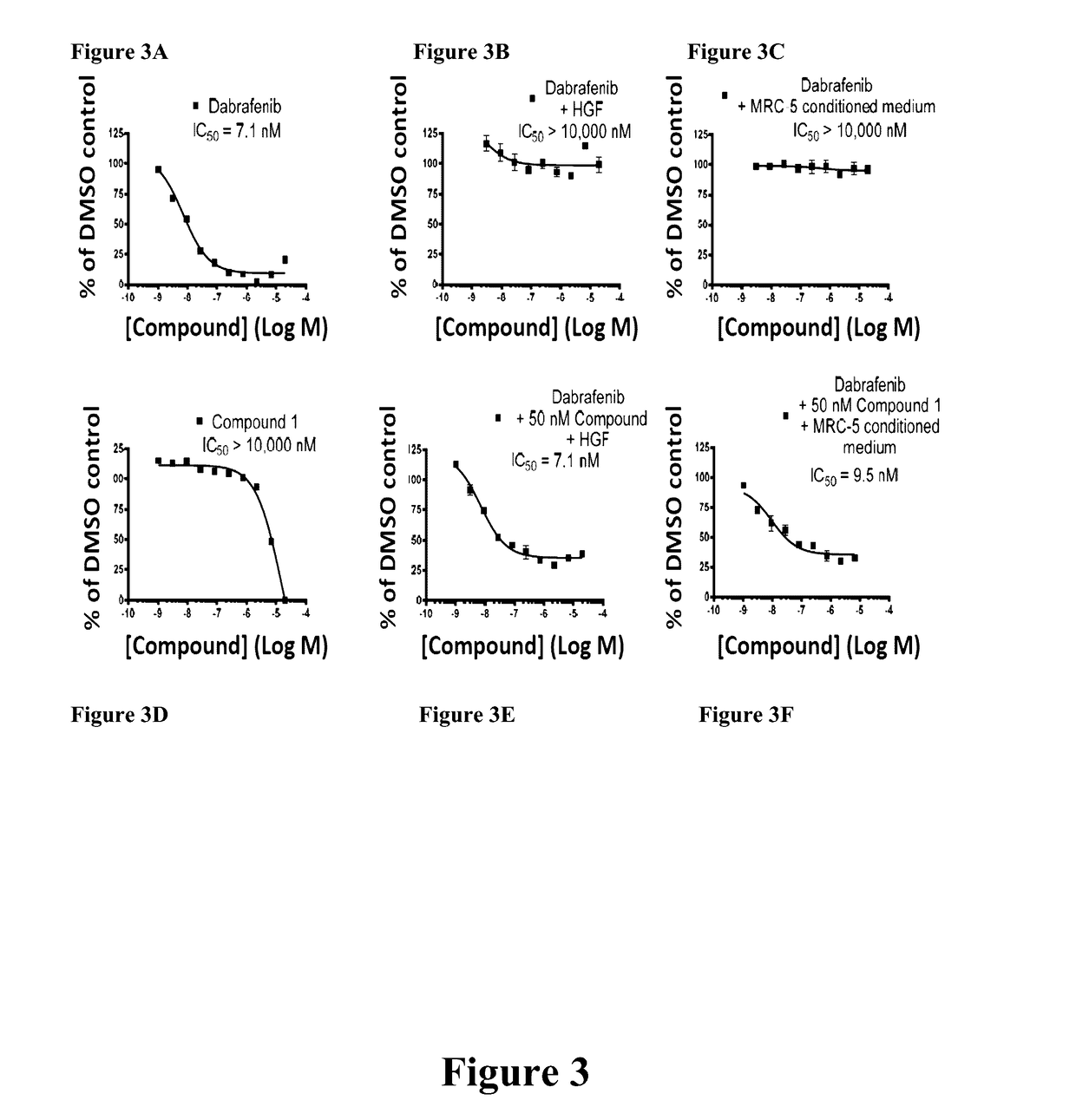Inhibition of tumor cell interactions with the microenvironment resulting in a reduction in tumor growth and disease progression
a tumor cell and microenvironment technology, applied in the direction of antibody medical ingredients, drug compositions, peptides, etc., can solve the problem of limiting the tumor response to chemotherapy and the effect of tumor growth
- Summary
- Abstract
- Description
- Claims
- Application Information
AI Technical Summary
Benefits of technology
Problems solved by technology
Method used
Image
Examples
example 1
Evaluation of Compound 1 in a Biochemical Assay for uTIE2 Kinase (SEQ ID No. 1)
[0054]Activity of uTIE2 kinase was determined by following the production of ADP from the kinase reaction through coupling with the pyruvate kinase / lactate dehydrogenase system [Schindler 2000]. In this assay, the oxidation of NADH (thus the decrease at A340 nm) was continuously monitored spectrophotometrically. The reaction mixture (100 μL) contained TIE2 (SignalChem) (5.6 nM), BSA (0.004% (w / v)), polyEY (1.5 mg / ml), MgCl2 (15 mM), DTT (0.5 mM), pyruvate kinase (4 units), lactate dehydrogenase (7 units), phosphoenol pyruvate (1 mM), and NADH (0.28 mM) and ATP (1.5 mM) in 90 mM Tris buffer containing 0.2% octyl-glucoside and 1% DMSO, pH 7.5. The inhibition reaction was started by mixing serial diluted test Compound 1 with the above reaction mixture. The absorption at 340 nm was monitored continuously for 6 hours at 30° C. on a plate reader (BioTek). The reaction rate was calculated using the 5 to 6 h time...
example 2
Evaluation of Compound 1 in a Biochemical Assay for MET Kinase (SEQ ID No. 2)
[0057]Activity of MET kinase (SEQ ID No. 2) was determined by following the production of ADP from the kinase reaction through coupling with the pyruvate kinase / lactate dehydrogenase system [Schindler 2000]. In this assay, the oxidation of NADH (thus the decrease at A340 nm) was continuously monitored spectrophotometrically. The reaction mixture (100 μl) contained MET (MET residues: 1050-1360, from Decode Biostructures, 7 nM), polyE4Y (1 mg / mL), MgCl2 (17 mM), pyruvate kinase (4 units), lactate dehydrogenase (7 units), phosphoenol pyruvate (1 mM), and NADH (0.28 mM) in 90 mM Tris buffer containing 1 mM DTT, 0.2% octyl-glucoside and 1% DMSO, pH 7.5. Test Compound 1 was incubated with MET (SEQ ID No. 2) and other reaction reagents at 22° C. for 0.5 h before ATP (100 μM) was added to start the reaction. The absorption at 340 nm was monitored continuously for 2 hours at 30° C. on a plate reader (BioTek). The re...
example 3
Evaluation of Compound 1 in a Biochemical Assay for VEGFR2 Kinase (SEQ ID No. 3)
[0060]The activity of VEGFR2 kinase was determined by following the production of ADP from the kinase reaction through coupling with the pyruvate kinase / lactate dehydrogenase system [Schindler 2000]. In this assay, the oxidation of NADH (thus the decrease at A340 nm) was continuously monitored spectrophotometrically. The reaction mixture (100 μl) contained VEGFR2 (SEQ ID No. 3, 2.7 nM, nominal concentration), polyE4Y (2.5 mg / mL), pyruvate kinase (4 units), lactate dehydrogenase (7 units), phosphoenolpyruvate (1 mM), and NADH (0.28 mM) in 90 mM Tris buffer containing 0.2% octyl-glucoside, 18 mM MgCl2, 1 mM DTT, and 1% DMSO at pH 7.5. The reaction was initiated by adding ATP (0.2 mM, final concentration). The absorption at 340 nm was continuously monitored for 3 h at 30° C. on a plate reader (Biotek) or instrument of similar capacity. The reaction rate was calculated using the 2 h to 3 h time frame. Percen...
PUM
| Property | Measurement | Unit |
|---|---|---|
| concentration | aaaaa | aaaaa |
| humidity | aaaaa | aaaaa |
| humidity | aaaaa | aaaaa |
Abstract
Description
Claims
Application Information
 Login to View More
Login to View More - R&D
- Intellectual Property
- Life Sciences
- Materials
- Tech Scout
- Unparalleled Data Quality
- Higher Quality Content
- 60% Fewer Hallucinations
Browse by: Latest US Patents, China's latest patents, Technical Efficacy Thesaurus, Application Domain, Technology Topic, Popular Technical Reports.
© 2025 PatSnap. All rights reserved.Legal|Privacy policy|Modern Slavery Act Transparency Statement|Sitemap|About US| Contact US: help@patsnap.com



